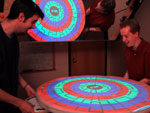 |
|||||||
| Brief
History of Jam-O-World
The original goals of the Jam-O-Drum project were: ·
To explore music and motion in graphics From these objectives, the community drum circle emerged as a metaphor to guide the form and content of the team's work at Interval. Bringing people together to explore rhythmical music in which every person has an equal position as observer and participant became the context for audiovisual improvisation. Another important element of this work included the integration of universal design concepts for accessibility and usability. Rather than creating an immersive musical environment with a projection display on a wall, the team focused on creating a shared physical object that people could gather around. In effect, turning the immersive space "inside-out". The original Jam-O-Drum prototype design incorporated six drum pads in a seven foot diameter circular table used as an integrated video projection surface. The Jam-O-Drum has
been exhibited at SIGGRAPH's Emerging Technologies and a version that
scales from 6 - 12 players is currently on exhibition at the Experience
Music Project in Seattle. A smaller prototype of the Jam-O-Drum has
recently become part of the Entertainment Technology Center's Curriculum. One of the input devices under development is a turntable that incorporates an optical encoder that records the direction the players turn the disks. This recent edition of the Jam-O-Drum is called the Jam-O-Whirl. In order to have better clarification between the Jam-O-Drum and the Jam-O-Whirl devices and interaction designs, the students and Tina conceived of Jam-O-World as the overarching name for the different versions of this multi-player instrument. Throughout the process of creating and developing new experiences for Jam-O-World, the students of the Entertainment Technology Center still try to remain true to the original goals and mission of the Jam-O-Drum, as specified above. |
Home
| Jam-O-World History | Jam-O-World
Experiences | Design Process | Exhibits
Jam-O-World System Design | People
| Press | Entertainment
Technology Center
 The
Jam-O-Rama project began in July 1998 at Interval Research to explore
new ways for people to make music collaboratively. Inspired by experiences
of communal music making in non-western cultures, Tina Blaine led a
creative team in the development of an interactive drumming table known
as the "Jam-O-Drum". This device allows groups of people with or without
previous musical knowledge to have shared audiovisual experiences by
integrating interactive music elements via MIDI with real-time video
and computer graphics projections in a collaborative environment. Exploring
this medium as a way to achieve community music making experiences and
to encourage spontaneous, unselfconscious behavior has been a focus
of her work.
The
Jam-O-Rama project began in July 1998 at Interval Research to explore
new ways for people to make music collaboratively. Inspired by experiences
of communal music making in non-western cultures, Tina Blaine led a
creative team in the development of an interactive drumming table known
as the "Jam-O-Drum". This device allows groups of people with or without
previous musical knowledge to have shared audiovisual experiences by
integrating interactive music elements via MIDI with real-time video
and computer graphics projections in a collaborative environment. Exploring
this medium as a way to achieve community music making experiences and
to encourage spontaneous, unselfconscious behavior has been a focus
of her work.